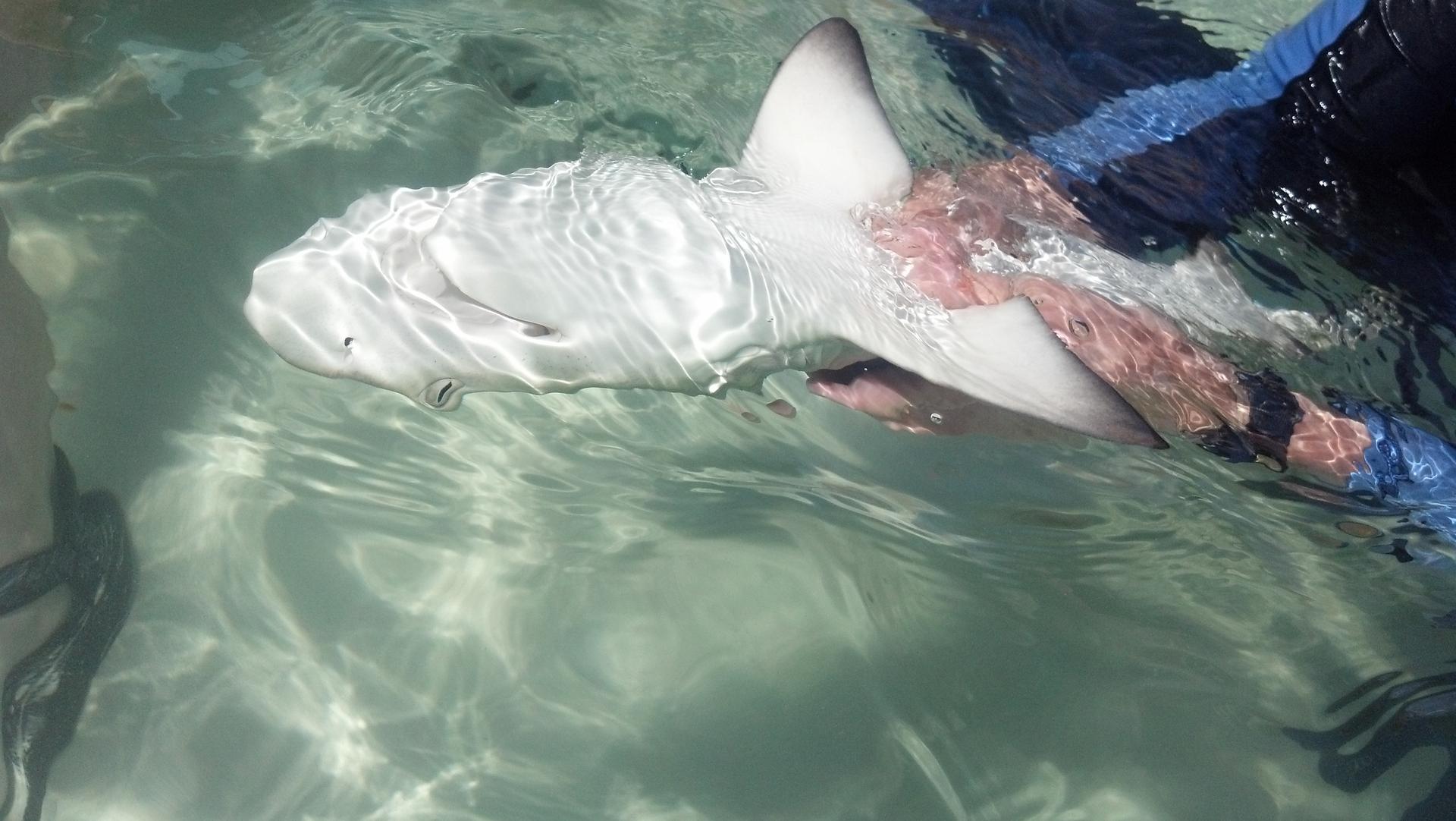Researcher looks for new ways to repel sharks
Field assistant T. J. Ostendorf holds a lemon shark in a seaside pen at Bimini Biological Field Station. The shark is turned upside down to induce a sleep-like state. A repellent is considered effective if it can rouse a shark from this state. (Photo by G
Eric Stroud stands on a pier on the island of North Bimini in the Bahamas and looks down into the turquoise water.
“The current is ripping through here right now,” he said. “The tide is going out. So any scent that’s put here goes right to the outside of the channel, and that’s where pretty much the big sharks are right now.”
Stroud is setting up an experiment. He unwraps twenty pounds of frozen sardines, drops them into a mesh bait bag tied to the pier, and tosses the bag into the water. He’s hoping to attract a large bull shark.
“It’s a fairly dangerous shark,” he explained. “It can be aggressive, especially when provoked or cornered.”
If a bull shark does show up, he’ll throw a large baited hook into the water. But it’s not your typical fishhook. In fact, if all goes well, this hook won’t catch any sharks.
For more than a decade, Stroud has been working to develop shark repellents.
He’s at the Bimini Biological Field Station to test his latest ideas.
Stroud, 38, used to work fulltime as a chemist in the pharmaceutical industry. Then, in the summer of 2001, he and his wife went on a cruise to Bermuda.
“We hit bad weather, and we were trapped in a cabin, and on the news was shark bite after shark bite,” he said. “It seemed like everyone that stepped in the ocean in Florida was getting attacked by a shark that summer.”
That’s when his wife suggested he turn his talents to developing shark repellents. When they got home, he set up several kiddie pools in his basement, and he filled them with small sharks.
He watched how the sharks fed, swam, and behaved. Then, one day, he accidentally dropped a large magnet from his workbench. He noticed some small nurse sharks dart away.
“That night, we put magnets into the tank and couldn’t believe [that] the nurse sharks were just extremely distressed and stayed away from them,” he said.
Stroud had discovered that magnets repel sharks.
He demonstrated that effect in a seaside pen in the Bahamas. His field assistant, T. J. Ostendorf, captured a small lemon shark and slowly rotated it onto its back, underwater. That put the shark into a sleep-like state.
Then Stroud took a magnet and spun it as he moved it toward the shark. The shark immediately bent away from the magnet — “like it’s another magnet,” Stroud said.
Sharks possess electrical sensors, called the ampullae of Lorenzini, that look like tiny freckles on their snouts. Biologists believe sharks use these sensors to detect the heartbeats of their prey and to navigate using the Earth’s magnetic field.
Stroud suspects the spinning magnet overwhelms those electrical sensors.
“It’s probably something like a bright flashlight across your eyes,” he said. “It’s just temporarily blinding, and you’re startled. And it’s not pleasant.”
Stroud made his discovery in 2004. It helped him jumpstart a company he’d founded, called SharkDefense, that aims to develop and commercialize shark repellents.
He and his team tested other substances, and they found that some non-magnetic metals also interfere with a shark’s electrical sensors. Particularly effective are rare-earth metals like samarium, neodymium, and praseodymium.
Stroud’s original plan was to develop repellents to protect people. For instance, he and his partners are researching a magnetized underwater fence that might keep sharks away from swimmers.
But his main focus has switched to using repellents to protect sharks.
Many shark species are being overfished, and some are endangered. One reason is that fishermen trying to catch other fish often catch sharks by accident. Stroud wondered – what if he could produce fishhooks that catch fish like tuna and halibut as usual, but that sharks avoid?
“We realized we could magnetize the fishing hook, and we can coat it with a rare earth metal,” he said. “It looks just like a regular hook, and we get the benefit of two repellents at the hook.”
Several countries are now testing his so-called SMART Hooks to see if they work. Some tests show a 60 to 70 percent reduction in the number of sharks caught.
Stroud received an award from the World Wildlife Fund for his invention, and he’s hoping to sell it commercially soon.
In the meantime, he continues to refine the design, trying new combinations of metals and magnets, and observing how they affect different types of sharks.
And that’s why he came to the pier on North Bimini Island to chum the waters for a large bull shark. He wanted to test a magnetized fishhook wrapped in a magnesium foil.
A couple of eagle rays and barracudas swam by, but there was no sign of a bull shark. His hook sat on the pier.
“Sometimes nothing happens quickly in shark repellent research,” he said with a smile.
Stroud waited for more than an hour.
“We have to try again,” he said as he pulled the bait bag in and dumped the sardines onto the pier.
He called it a day.
Eight years after the chance discovery in his New Jersey basement, Stroud has come to accept that product development is a slow process. But his attraction to repellents runs deep, and he says the sharks keep luring him back.
